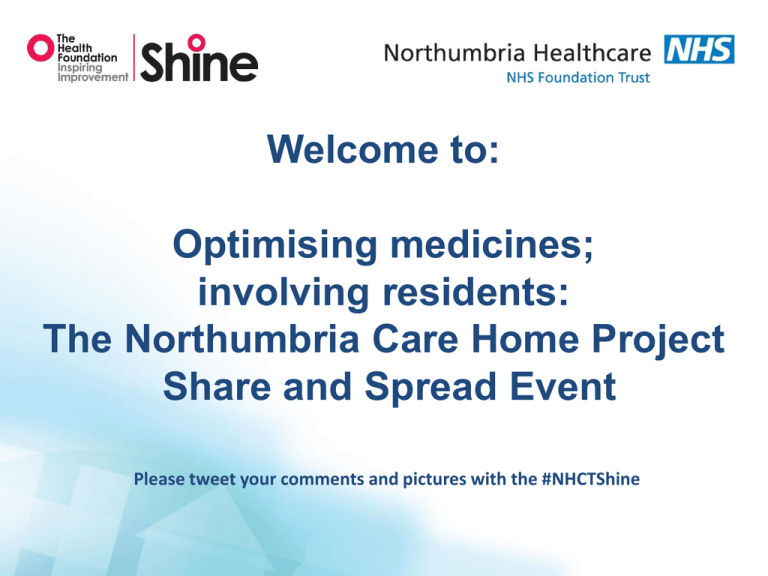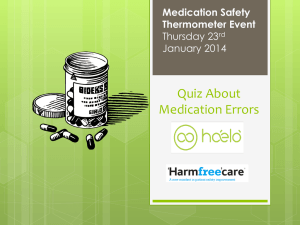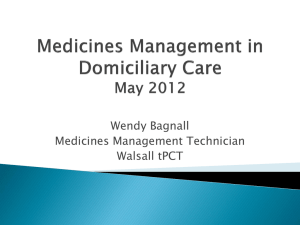SHINE Project - The Health Foundation
advertisement

Welcome to: Optimising medicines; involving residents: The Northumbria Care Home Project Share and Spread Event Please tweet your comments and pictures with the #NHCTShine Get involved! WiFi (subscriber login) Newcastle_WiFi_SPARK Login: arc Password: Racecard #NHCTShine @NorthumbriaNHS @NHCTPharmacy Annie Laverty Director of Patient Experience Optimising Medicines, Involving Residents: Learning from the Northumbria Shine Project Wasim Baqir on behalf of the SHINE project team Medicines Use in Care Homes Excess medicines (unnecessary, inappropriate) Lack of structured review Lack of patient involvement Ethel Our objective Optimise medicines use in care home residents… …ensuring that residents or their family are fully involved in any decisions around prescribing and stopping medicines A clinico-ethical framework for multidisciplinary review of medication in nursing homes • Is the medication currently performing a function? • Is the medication still appropriate when taking comorbidities into consideration? • Is the medication safe? • Are there medicines missing that the patient should be taking? • Is the patient/family/carer fully involved in any decision about their medicines • Medicines Screen & review by Shine Pharmacy Team • Discussion with GP Review MDT • MDT discussion • POAS consultant, CBT nursing team, Care home nurses • Patient, family & carers involved in any decisions Shared Decisions Follow up • Hotline for urgent advice • Follow up Results and Learning What worked well? • Pharmacist led reviews • MDTs with pharmacists and care home nurses Our goal… • Residents and family discussing the issues as a member of the MDT Involving Patients: Our Model Patient 1:1 16% Family 1:1 Family by letter 41% Advocacy 39% 4% Working with GPs & Residents Carehome N residents Assumption 1: that all residents receive same MDT model Pharmacist Review of Medical Notes (at GP practice or at hospital) Model 0: No GP involvement Model 2: Review discussed with GP prior to MDT MDT Model 3: Review discussed with GP after MDT Pharmacist and Care home Nurse Model 1: GP attends MDT Patient/Family/ Advocate Involvement Model A Patient present at review POAS referral: 1. New patient 2. Existing patient 3. Telephone/Email advice Patient/Family/ Advocate Involvement Model B Review discussed with patient or letters sent Decisions Made Data entry on to clinical system and project database Working with POAS • POAS at each MDT was inefficient • Three levels of psychiatry involvement developed… – Existing patient (team alerted) – New patient referral – Email or telephone advice • Relationships The numbers! • 422 residents reviewed in 20 care homes • 16 general medical practices • 1346 interventions in 91% (384) patients – 15 different types of intervention – Most common: STOP Medicines Stopping Medicines Prior to review Post review 0 n meds 1000 Post review 2975 2000 3000 Prior to review 3602 4000 • 704 medicines stopped • 17.4% reduction in medicines use • Average number of medicines per resident: 97 “He explained things in layman terms. Pharmacist couldn’t tell us to take [mum] off the medication but he told us the pros and the cons and it was our decision and at least we were able to make an informed decision from the information from the pharmacist” Daughter of resident “Because there are so many things you are not sure about with elderly people and their medication and health condition. Anything that gives you an opportunity to talk to someone directly and get feedback and get confirmation or alternative suggestions, that is great as far as I am concerned”. Jane, 89y • Sits quietly; never engages; drowsy “She’s been like this for years; that’s how our Jane is” Nurse “Mum’s always been like this” Daughter Improving Quality whilst reducing Costs Prescribing Net Savings £77,852 Costs Added Savings £0 Costs £10,000 £20,000 Savings £81,989 £30,000 £40,000 £50,000 £60,000 £70,000 £80,000 £90,000 Costs Added £4,138 • £184 saved for every 1 resident reviewed • >£70 million could be saved across England Models n patients 0 21 1 3 Totals 115 160 21 126 422 3.2 3.5 3.8 2.7 3.2 1.7 1.9 2.4 1.2 1.7 £204.02 £233.84 £203.71 £100.77 £184.48 Outputs Intervention/pati ent Medicine stopped/patient Net saving/patient Cost of delivering service Cost per patient £57.81 £92.09 £73.75 £77.29 £77.42 £3.53 saved £2.54 saved £2.76 saved £1.30 saved £2.38 saved Summary For every £1 invested… Other Efficiencies • Reduced medicines waste • Medicines administration time – 6.6 hours per week saved per home 200 180 160 140 120 100 80 60 40 20 0 CH1 CH2 CH3 CH4 “Our drugs round had decreased by approximately 20%. It is less stressful for residents as they are not taking as much medication and are more compliant as they were part of the review process” Care home nurse “As a manager I feel special to have been chosen for this project. I think it is beneficial and forward thinking to be involved in the research of medication for the elderly; this is often overlooked and not to the forefront either. I told anyone that would listen that we were part of the Shine project with pride” Care home manager The Team • Wasim Baqir – Project Lead • Prof Julian Hughes (POAS/Newcastle Uni) – Clinical Lead • Peter Derrington – Project Manager • Nisha Desai/ Steven Barrett – Clinical Pharmacists • Annie Laverty (Director of Patient Experience) • Jo Mackintosh – Patient Experience • Dr Jane Riddle – GP Advisor • Yvonne Storey – Communications • Richard Copeland/ David Campbell – Senior Pharmacy Support • Sandra Gray/John Connelly (Age UK) – Patient Advocate Involving residents, sharing decisions about medicines, leads to better quality and less costly care http://tinyurl.com/NHCTShine Capacity Assessments in Care Homes Professor Julian Hughes Northumbria Healthcare NHS Foundation Trust and PEALS Research Centre, Newcastle University Plan • • • • • • • Covering the basics The Shine Way Presuming capacity The issue of medication Capacity and complexity Validation Conclusions To start at the end • ‘The means by which we evaluate, and arrive at our conclusions about the afflicted person’s competency may well ultimately be a test of our own competency as thoughtful, judicious, humane human beings.’ Sabat SR. The experience of Alzheimer’s disease: life through a tangled veil; p334. Blackwell, Oxford, 2001 The basics Back to the beginning MCA 2005 – Section 1: the principles • A person is assumed to have capacity • All practicable steps must be taken to help the person to make a decision • People are entitled to make unwise decisions • Any actions taken on behalf of a person who lacks capacity must be in the person’s best interests • Before any action is taken it should be the least restrictive of the person’s rights and freedom of action Assessment of capacity – definition Section 2(1): • ‘…a person lacks capacity in relation to a matter if at the material time he is unable to make a decision for himself in relation to the matter because of an impairment of, or a disturbance in the functioning of, the mind or brain.’ Assessment of capacity – two-stage test (see Code of Practice §§ 4.10-4.13) • Stage 1: Does the person have an impairment of, or a disturbance in the functioning of, their mind or brain? • Stage 2: Does the impairment or disturbance mean the person is unable to make a specific decision when they need to? Assessment of capacity – two-stage test (see Code of Practice §§ 4.10-4.13) • Stage 1: Does the person have an impairment of, or a disturbance in the functioning of, their mind or brain? • Stage 2: Does the impairment or disturbance mean the person is unable to make a specific decision when they need to? • Understand • Retain • Use or weigh • Communicate Best interests • Any actions taken on behalf of a person who lacks capacity must be in the person’s best interests Some of the checklist (1) • Avoid discrimination • Consider all the relevant circumstances • Put off the decision if the person is likely to regain capacity • Encourage the person to participate as fully as possible • If the decision is about life-sustaining treatment, ensure it is not motivated by a desire to bring about the person’s death The checklist (2) • So far as is reasonably ascertainable consider: – The person’s past wishes and feelings – The person’s present wishes and feelings – The person’s values and beliefs likely to influence the decision – Other factors the person might consider, e.g. cultural background, religious beliefs, political convictions, past behaviour or habits and any effects on others that might be relevant to the person The checklist (3) • If it is practicable and appropriate, consult: – – – – – Anyone named by the person Anyone engaged in caring for the person Anyone interested in the person’s welfare Any donee of a LPA (or EPA) A deputy appointed by the court Lasting Power of Attorney MCA Sections 9-14 (And remember deputyship) • Two types: – Property and affairs LPA • Can be used when the person still has capacity – Personal welfare LPA • Can only be used when the person lacks capacity The Shine Way • Informal assessments • Senior nurse asked: “does the resident have capacity to make decisions about treatment?” Presuming Capacity When should capacity be assessed? Code of Practice Section 4.34 • ‘Assessing capacity correctly is vitally important to everyone affected by the Act. Someone who is assessed as lacking capacity may be denied their right to make a specific decision – particularly if others think that the decision would not be in their best interests or could cause harm. Also, if a person lacks capacity to make specific decisions, that person might make decisions they do not really understand. Again, this could cause harm or put the person at risk. So it is important to carry out an assessment when a person’s capacity is in doubt. It is also important that the person who does an assessment can justify their conclusions.’ The issue of medication • • • • Capacity to decide who makes decisions? Is it global judgements? Is it specific judgements? Should people in care homes be required to demonstrate a higher level of capacity than the person on the Clapham Omnibus? Capacity and Complexity • • • • Being on the side of the resident The danger of paternalism Autonomy and dependence The role of clinical judgement Validation study(1) (with thanks to James Clark) • 22 residents in one EMI nursing home (NB) • Interviewed for about 15 minutes (in one case one hour) • Capacity to decide to be involved in decisions about medication • Good and bad points of deciding to have decisions made for them discussed • Asked to repeat this information • Asked to make a decision Validation study(2) Results • Average age 81 years • Clinical Dementia Rating Scale (CDR): 2.66 • Both informal and formal assessments matched in 86% of cases (19/22) • Informal interview good sensitivity: picked up those who lacked capacity, but was not specific Validation study(3) • Mrs A: 83, very dependent, problems with agitation, CDR high, difficult to engage, speech problems, but then very clear about her views: satisfied with care and wanted decisions made for her • Mrs B: 65, very fluent, but unable to make a decision and reasoning based on false beliefs, despite being given extended time Conclusions • • • • • Capacity assessments are not easy But we need to get them right Pressure of time (and training) Citizenship in care homes And ‘own competency as thoughtful, judicious, humane human beings.’ THANK YOU julian.hughes@ncl.ac.uk Shared Decision Making Steven Barrett, Senior Clinical Pharmacist “When we want your opinion, we’ll give it to you” http://www.advancingqualitynw.nhs.uk/sandbox/SDM3/Information-for-Clinicians.html# Using Shared Decision Making • Collaborative conversation between patient and health professional to reach a healthcare choice together • Professional provides evidence-based options - outcomes, benefits, risks, uncertainties • Patient provides their experiences, values, preferences 3 Questions Approach • What are my options? • What are the benefits and harms? • How likely are these? Shepherd HL et al. Patient Educ Couns (2011) http://www.health.org.uk/areas-of-work/ programmes/shared-decision-making/learning/ Examples of SDM Tools • Brief Decision Aids http://www.patient.co.uk/decision-aids/ • Option Grids http://www.optiongrid.org/ • Patient decision aids http://sdm.rightcare.nhs.uk/ • Cates plots http://www.nntonline.net/ Treatment of stable angina Statin Prescribed These people will not have a CV event, whether or not they take a statin These people will be saved from having a CV event because they take a statin These people will have a CV event, whether or not they take a statin Interactive Examples A Care Home Managers View Point Sylvia Dixon, Care Home Manager Break Please tweet your comments and pictures with the #NHCTShine Being involved: a carer’s reflections Dorothy O’Neill, Carer How to undertake a medication review Nisha Desai, Senior Clinical Pharmacist Overview • What is a medication review? • What is the importance of a medication review? • Real life cases What is a medication review? Definition • “A structured, critical examination of a patient’s medicines with the objective of reaching an agreement with the patient about treatment, optimising the impact of medicines, minimising the number of medication-related problems and reducing waste” Levels of medication review Level 0 Level 1 Level 2 Level 3 • Adhoc • Opportunistic • Prescription Review • Treatment Review • With medical notes • Clinical Medication Review • Face-to-face Clinical medication review • Conducted by a prescriber • Involves patient/carer • Access to various sources of information e.g. GP records, hospital notes, care home records Key Questions Key questions to ask Is the medicine safe and appropriate? Does the resident want to take the medicine? Key question 1 • Has patients condition/comorbidities changed? • Medicines may have been prescribed acutely • Risk vs benefit • Ethical considerations during end of life care Key question 2 • Drug-drug interactions • Drug-food interactions Is the medicine safe and appropriate? • Drug-disease interactions • Dose • Formulation Key question 3 • Adherence • Reasons for non-adherence (if a problem) Is the medicines safe and appropriate? Does the resident want to take the medicine? • Residents’ understanding of risks/benefits of taking a medicine Missing medicines? • Are there any medicines, not currently prescribed, that the patient would benefit from? • Has the patient previously been on the medicine? If so, why was it discontinued? • Has the medicine ever been considered? If yes, why was it not commenced? Case Studies Case study 1 • 94 yr old female • Residential home • Good communication – talks and can retain info. • Has capacity (wants to involve daughter as well) • Mobilises independently with gutter frame • Good nutritional status • No problems with medicines adherence PMH: • Essential hypertension – 2002 • Hip fracture (# Left NOF) – 2007 • Osteoporosis – 2007 • Hip fracture (# Right NOF) 2013 Case study 1 • Acute medication: • Canesten HC cream as directed Repeat medication: paracetamol 1g QDS amitriptyline 10mg ON calcium carbonate and colecalciferol chewable tabs 1.5g/10microg 1 BD E45 Shower cream as directed E45 cream apply PRN gabapentin 600mg TDS Piroxicam gel 0.5% apply BD senna 15mg ON docusate sodium 200mg BD nefopam 60mg TDS Case study 1 WHAT CHANGES, IF ANY, WOULD YOU MAKE TO THIS RESIDENTS’ MEDICATION? Case study 1 Medication Information Paracetamol Takes 1g QDS habitually. No complaints of pain. Amitriptyline Commenced 2008 for pins & needles (Hx Herpes Zoster 2006). Current falls risk (geriatrician letter states to r/v). Gabapentin Commenced 2008 post #. E45 Shower cream Not issued since 2012. Piroxicam gel Uses PRN to both knees. Maybe 1-2 times/week. Senna Takes regular. Bowels stable. Docusate sodium Takes regular. Bowels stable. Nefopam Commenced post #NOF – was due a r/v 2/52 after but never happened. ANY OTHER NEW MEDICATION? Case study 1 Medication Outcome Paracetamol Takes 1g QDS habitually. No complaints of pain. Switch to PRN and to reduce quantity ordered. Amitriptyline Commenced 2008 for pins & needles (Hx Herpes Zoster 2006). Current falls risk (geriatrician letter states to r/v). Stop medicine. Gabapentin Commenced 2008 post #. To reduce to 300mg TDS after stable without amitriptyline. E45 Shower cream Not issued since 2012. Removed from repeat list. Piroxicam gel Uses PRN to both knees. Maybe 1-2 times/week. Continue. Senna Takes regular. Bowels stable. Continue. Docusate sodium Takes regular. Bowels stable. Continue. Nefopam Commenced post #NOF – was due a r/v 2/52 after but never happened. Stop medicine. Bisphosphonate Previously been on alendronic acid, but no documentation of it being stopped. Has hx of falls, but patient did not like it. Not to start. Case study 2 • 89 year old male PMH: • Residential home • Hypertension • Iron deficiency anaemia • Hiatus hernia • Type 2 DM • Oesophageal ulcer (2012) • Frequent falls (2013) • Ability to hold a conversation but no capacity to make decisions about medication (liaise with daughter) • Mobilises with wheelchair • Fair appetite, has a large breakfast . BMI = 25.5 • No problems with medicines adherence Case study 2 • Acute medication: • lansoprazole 30mg OD Repeat medication: paracetamol 1g QDS aspirin dispersible 75mg OM citalopram 20mg OM simvastatin 40mg ON ramipril 2.5mg OM Ensure Plus Liquid Feed Milkshake 1 TDS thiamine 100mg BD vitamins 1 OM vitamin b co strong 1OM Pro-Cal shot 30mls OD codeine phosphate 30mg QDS olive oil ear drops 2 drops BD to both ears Hydromol ointment apply QDS PRN lansoprazole 15mg OD zopiclone 15mg ON PRN Case study 2 WHAT CHANGES, IF ANY, WOULD YOU MAKE TO THIS RESIDENTS’ MEDICATION? Case study 2 Medication Outcome Citalopram New to practice and old notes not comprehensive. No PMH of depression. Ensure Plus Current BMI 25.5 and eating well. Procal Current BMI 25.5 and eating well. Thiamine No current indication. Vitamins No current indication. Vitamin B Co Strong No current indication. Olive oil ear drops No current indication. Acute episode. Simvastatin Secondary prevention. DM & HTN but no cardiac events. Lansoprazole Confirmed on 15mg OD (previous ulcer). Zopiclone No current indication. Was commenced whilst in-patient at NTGH. No trouble sleeping, has naps during day. Case study 2 Medication Outcome Citalopram New to practice and old notes not comprehensive. No PMH of depression. Reduced to 20mg OD alt.days for 2/52 then stop. Ensure Plus Current BMI 25.5 and eating well. Stopped dietary supplements. Procal Current BMI 25.5 and eating well. Stopped dietary supplements. Thiamine No current indication. Discontinued. Vitamins No current indication. Discontinued. Vitamin B Co Strong No current indication. Discontinued. Olive oil ear drops No current indication. Acute episode. Discontinued. Simvastatin Secondary prevention. DM & HTN but no cardiac events. Discussion with daughter and happy to discontinue. Lansoprazole Updated records and confirmed on 15mg OD (previous ulcer) Zopiclone No current indication. Was commenced whilst in-patient at NTGH. No trouble sleeping, has naps during day. Discontinued. THANK YOU FOR LISTENING A Nurses Perspective Melanie Johnson, Nurse Practitioner / Nurse Manager Closing Remarks And Q & A Wasim Baqir, Research & Development Pharmacist Thank You for Attending







